


How to find micro-influencers?
How to find micro-influencers?
How to find micro-influencers?
How to find micro-influencers?
Open social media profiles and search manually ❌
Open social media profiles and search manually ❌
Find micro-influencers who fit your brand in seconds! ✅
Find micro-influencers who fit your brand in seconds! ✅
SocialiQ 2.0 makes influencer discovery faster than ever!
SocialiQ 2.0 makes influencer discovery faster than ever!

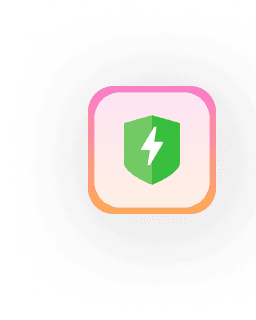

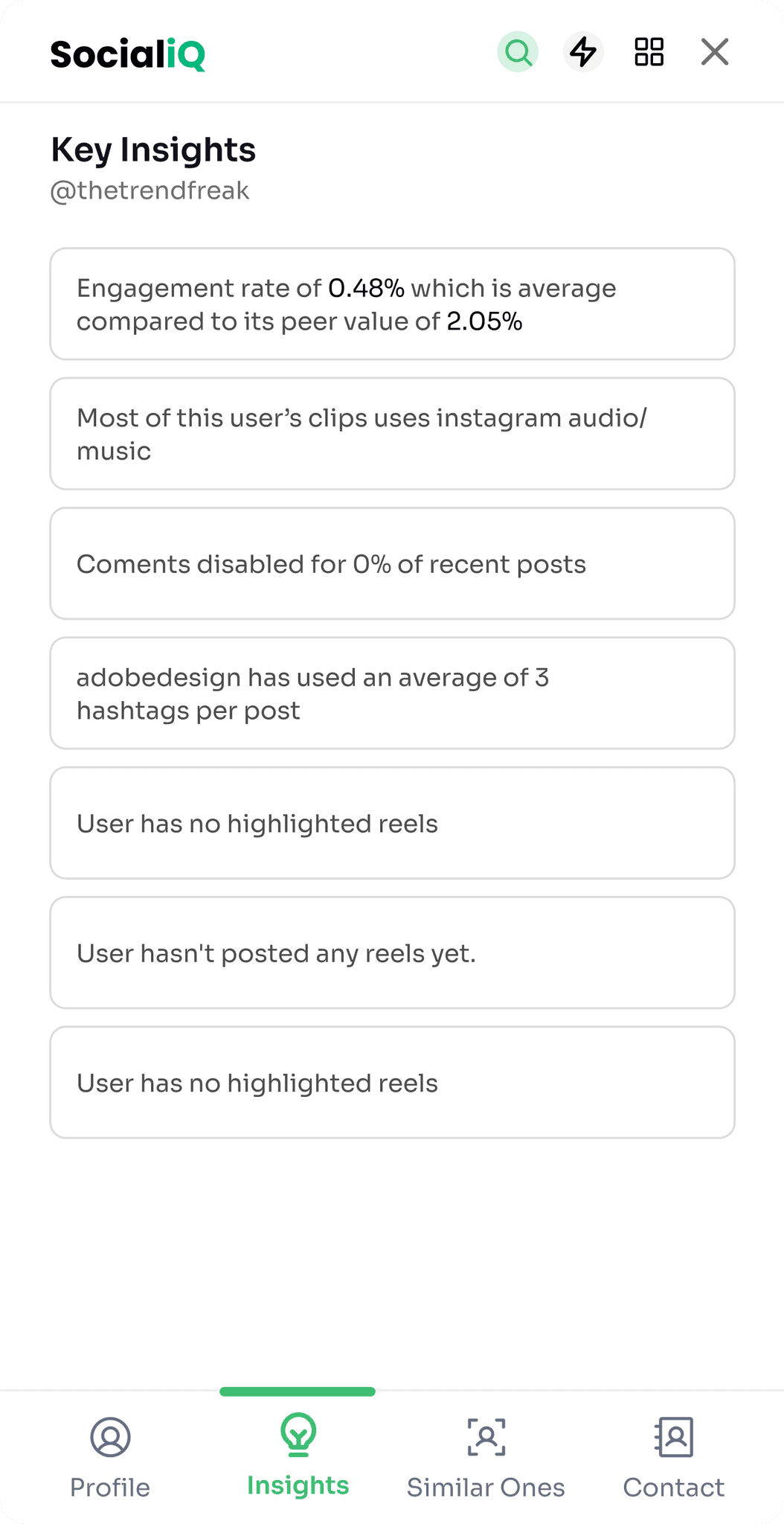


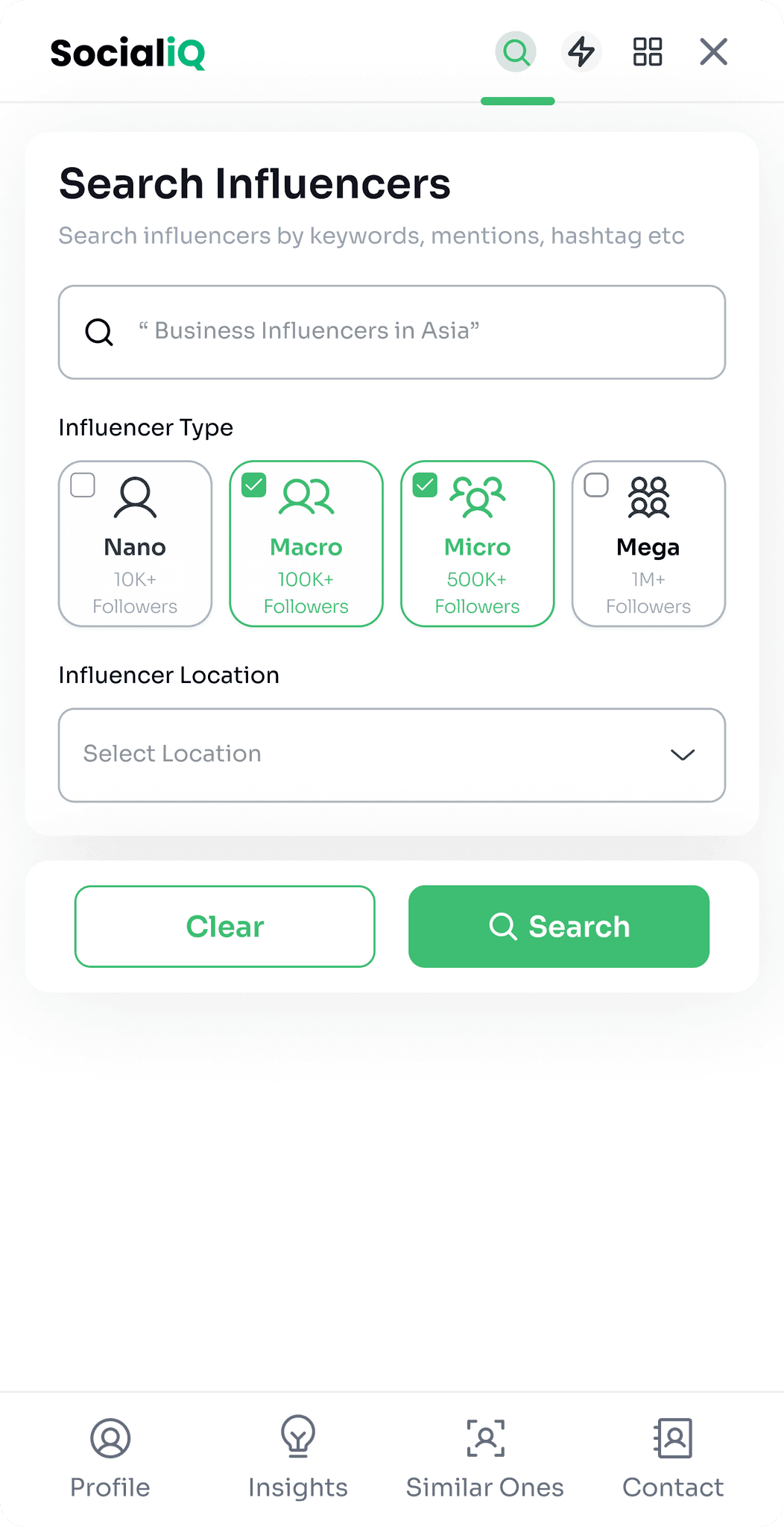





















SocialiQ 2.0 shows relevant profiles instantly.
SocialiQ 2.0 shows relevant profiles instantly.
SocialiQ 2.0 shows relevant profiles instantly.
Ready to see how?
Ready to see how?
Ready to see how?
Think of SocialiQ as your personal Influencer Marketing Assistant (IMA).
Think of SocialiQ as your personal Influencer Marketing Assistant (IMA).
Here’s what this IMA can do for you:
Here’s what this IMA can do for you:


01
Search by Keywords & Filters
Set location and follower size. Click ‘Search.’ Watch SocialiQ 2.0 do the work.


01
Search by Keywords & Filters
Set location and follower size. Click ‘Search.’ Watch SocialiQ 2.0 do the work.


01
Search by Keywords & Filters
Set location and follower size. Click ‘Search.’ Watch SocialiQ 2.0 do the work.


01
Search by Keywords & Filters
Set location and follower size. Click ‘Search.’ Watch SocialiQ 2.0 do the work.

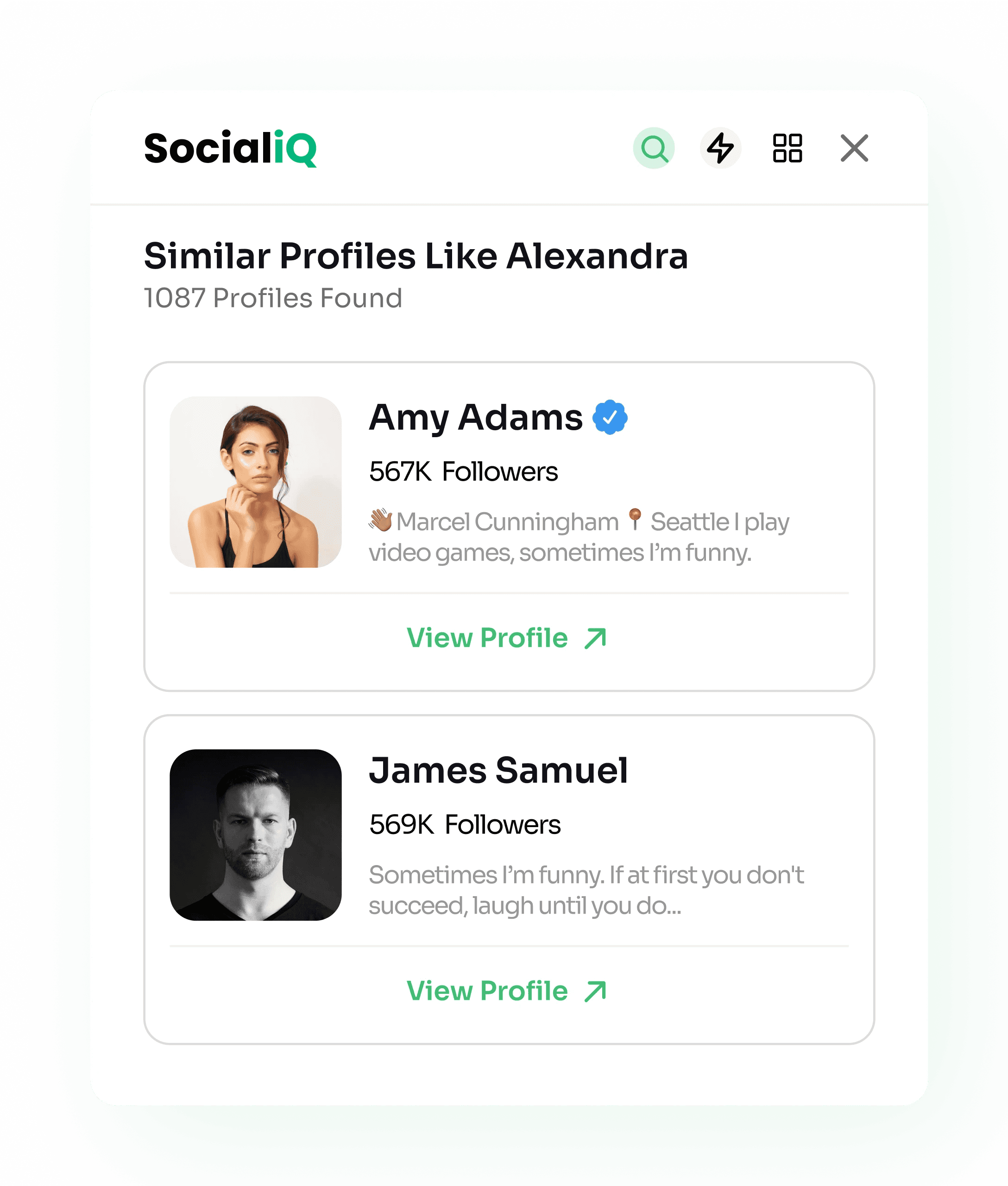
02
Discover Similar Profiles
Liked one influencer? Get a list of similar profiles that fit your criteria with just a click.


02
Discover Similar Profiles
Liked one influencer? Get a list of similar profiles that fit your criteria with just a click.


02
Discover Similar Profiles
Liked one influencer? Get a list of similar profiles that fit your criteria with just a click.


02
Discover Similar Profiles
Liked one influencer? Get a list of similar profiles that fit your criteria with just a click.

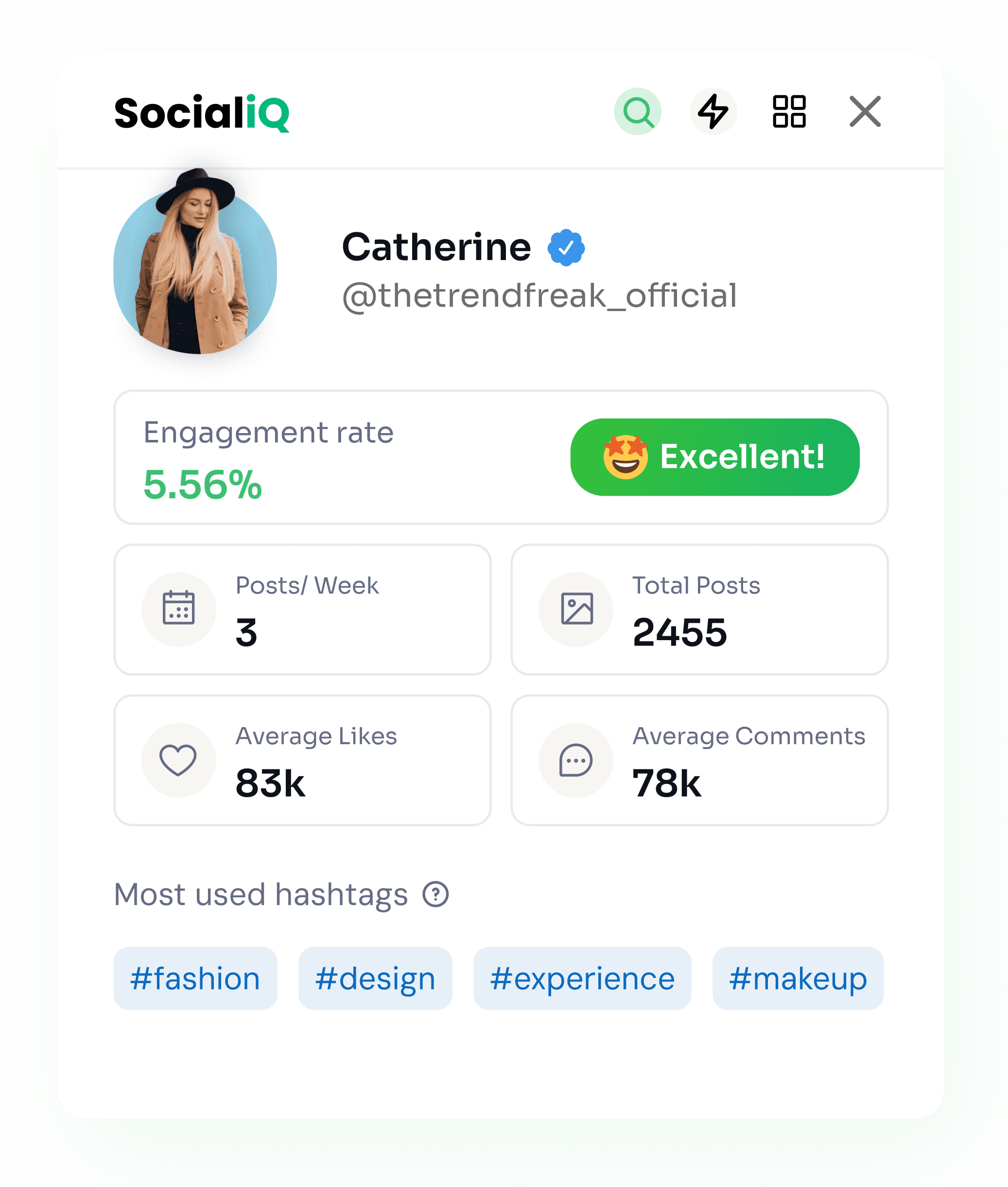
03
Access Quick Insights
Know public/private account status, engagement rate, and how the micro-influencer is doing compared to others in their niche.


03
Access Quick Insights
Know public/private account status, engagement rate, and how the micro-influencer is doing compared to others in their niche.


03
Access Quick Insights
Know public/private account status, engagement rate, and how the micro-influencer is doing compared to others in their niche.


03
Access Quick Insights
Know public/private account status, engagement rate, and how the micro-influencer is doing compared to others in their niche.

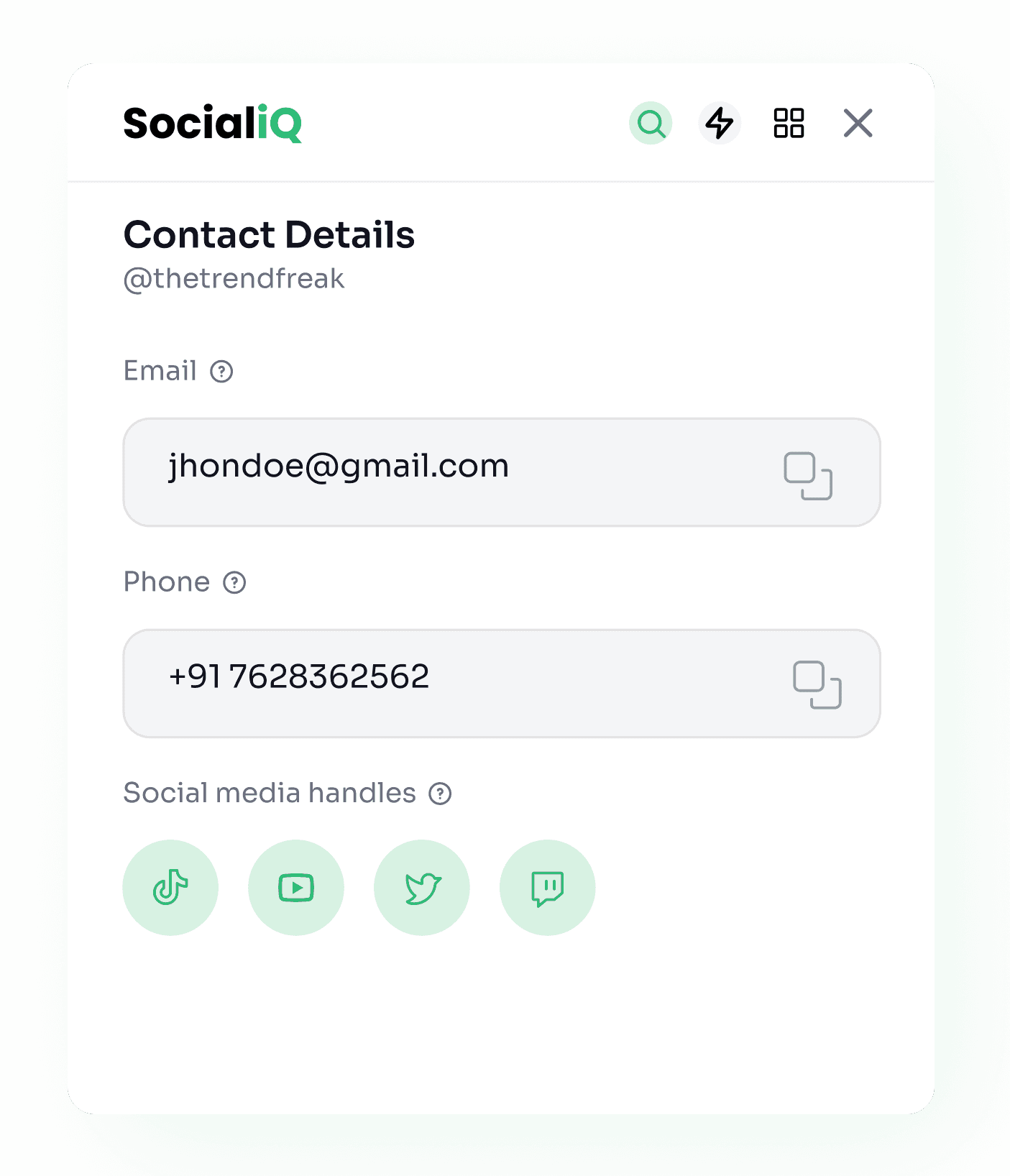
04
Get Contact Details
Click ‘get contact info.’ We will get the contact details from our database of 250 million+ profiles.


04
Get Contact Details
Click ‘get contact info.’ We will get the contact details from our database of 250 million+ profiles.


04
Get Contact Details
Click ‘get contact info.’ We will get the contact details from our database of 250 million+ profiles.


04
Get Contact Details
Click ‘get contact info.’ We will get the contact details from our database of 250 million+ profiles.
Find micro-influencers without leaving social media.
Find micro-influencers without leaving social media.
Use this IMA to find Instagram, TikTok, or YouTube influencers quickly without switching between tabs.
Use this IMA to find Instagram, TikTok, or YouTube influencers quickly without switching between tabs.
Use this IMA to find Instagram, TikTok, or YouTube influencers quickly without switching between tabs.
So you can focus on what matters: Growing Your Brand.
So you can focus on what matters: Growing Your Brand.
So you can focus on what matters: Growing Your Brand.
And the best part? It’s free to try!
And the best part? It’s free to try!
Want to get your own IMA?
Want to get your own IMA?
Why Work with Micro-Influencers?
Why Work with Micro-Influencers?
Why Work with Micro-Influencers?
Macro Vs. Micro-Influencers
Macro Vs. Micro-Influencers
Macro Vs. Micro-Influencers
How Much Do Micro-Influencers Charge Per Post?
How Much Do Micro-Influencers Charge Per Post?
How Much Do Micro-Influencers Charge Per Post?
Why do Engagement Rates Matter More Than Follower Count?
Why Do Engagement Rates Matter More Than Follower Count?
Why Do Engagement Rates Matter More Than Follower Count?
Finding the Right Influencers for Your Brand/Niche
Finding the Right Micro-Influencers for Your Brand/Niche
Finding the Right Micro-Influencers for Your Brand/Niche
How to Measure Micro-Influencer Campaign Success?
How to Measure Micro-Influencer Campaign Success?
How to Measure Micro-Influencer Campaign Success?
Frequently Asked Questions
Insights About Working With Micro-Influencers
Insights About Working With Micro-Influencers

Want to Take This Experience
to the Next Level?
Want to Take This Experience
to the Next Level?
Yep, we don’t just stop here.
Think of getting access to deeper analysis like audience demographics, check fake followers, and curate campaign-centric lists. All this and so much more with impulze.ai.
Why Work with Micro-Influencers?
Why Work with Micro-Influencers?
Working with a micro-influencer benefits a brand due to high engagement, niche audiences, and trust that their followers have in them. You don’t need millions of followers to see results—sometimes, the smaller voices make the biggest impact. Plus, micro-influencers marketing and talking about a brand is cost-effective.
Benefits of working with micro-influencers:
Higher Engagement Rates: Micro-influencers tend to have higher engagement, sparking real conversations with followers.
Stronger Audience Connections: Their niche followings see them as trusted voices, making brand promotions feel genuine.
Cost-Effective Influencer Campaigns: Collaborating with micro-influencers stretches budgets further, maximizing reach.


Macro Vs. Micro-Influencers
Macro Vs. Micro-Influencers
Why choose micro-influencers? Here’s why smaller is often stronger:
Higher Engagement: Micro-influencers often see higher engagement rates, sparking real conversations.
Deeper Trust: Their followers see them as relatable, leading to authentic recommendations.
Cost-Effective Partnerships: Micro-influencer marketing offers impactful results without the big spend.
Niche Audiences: Connect directly with specific interests and communities for focused impact.
Want to know more about why micro-influencers are better and see micro-influencer examples? Or decide whether you should work with micro- or macro-influencers? Here’s an article that can help you decide.
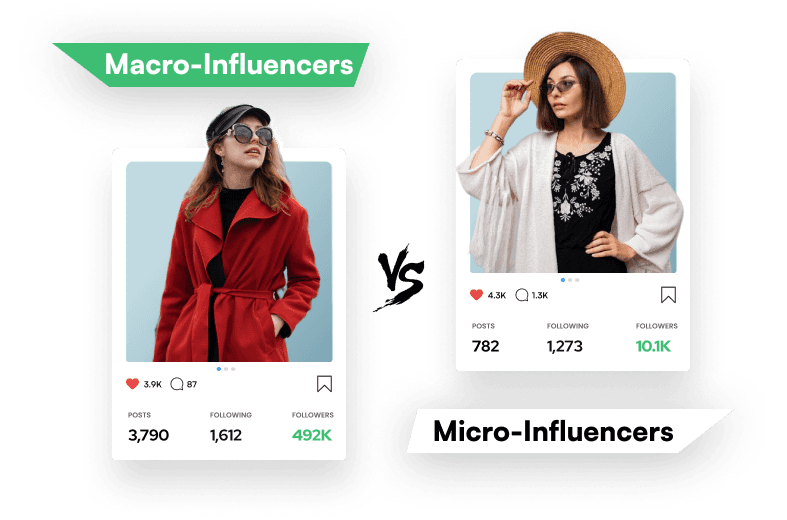
How Much Do Micro-Influencers Charge Per Post?
How Much Do Micro-Influencers Charge Per Post?
Rates for micro-influencers can vary widely based on a few key factors. On average, expect anywhere from $100 to $500 per post. This amount can reach $1,000 for more experienced influencers with high engagement rate.
Factors Impacting Cost:
Followers: Micro-influencers with higher follower counts within the range of 10K–100K tend to charge more.
Engagement Rate: Higher engagement (likes, comments, shares) often leads to a higher rate.
Micro-Influencers Platform Type: Instagram, TikTok, and YouTube each have distinct average rates due to content formats—Instagram cost is generally less than video-heavy TikTok or YouTube posts.


Why Do Engagement Rates Matter More Than Follower Count?
Why Do Engagement Rates Matter More Than Follower Count?
Big numbers can be enticing, but engagement drives true impact. Here’s why engagement rates are crucial:
Good Engagement Rate: Micro-influencers with 3–5% engagement have strong, loyal audiences; 5%+ is exceptional.
Quality Over Quantity: A smaller, active audience can drive more impact than a large, passive one, inspiring trust and authenticity.
Red Flags: Low engagement (<1%) on large followings may signal fake or inactive audiences, adding little value.
ROI Boost: High engagement leads to better click-through rates, conversions, and stronger ROI.
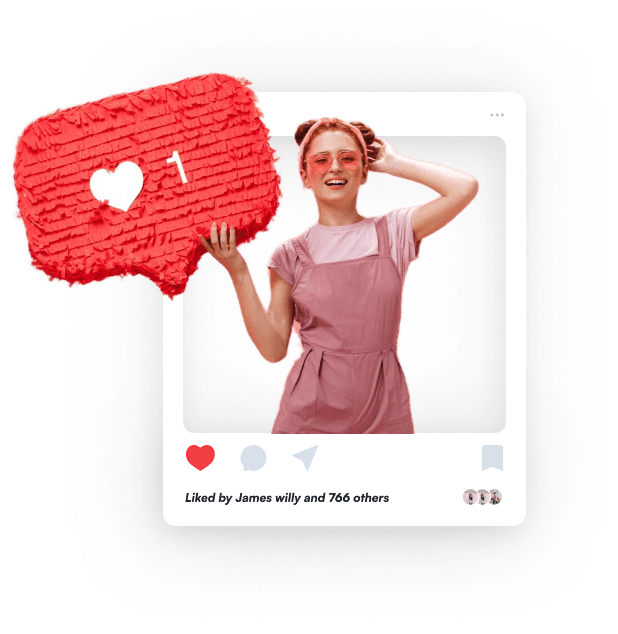

Finding the Right Micro-Influencers for Your Brand/Niche
Finding the Right Micro-Influencers for Your Brand/Niche
Focus on quality influencers who resonate with your audience:
Keywords: Use industry-specific keywords (e.g., ‘organic skincare’) to find niche influencers.
Hashtags: Search relevant hashtags (#WellnessJourney) to identify micro-influencers with similar audiences.
Demographics: Check if followers align with your target age, location, or interests.
Pro Tip: impulze.ai’s filters help you quickly find micro-influencers with your target audience. This saves time, giving you instant access to a micro-influencers list.
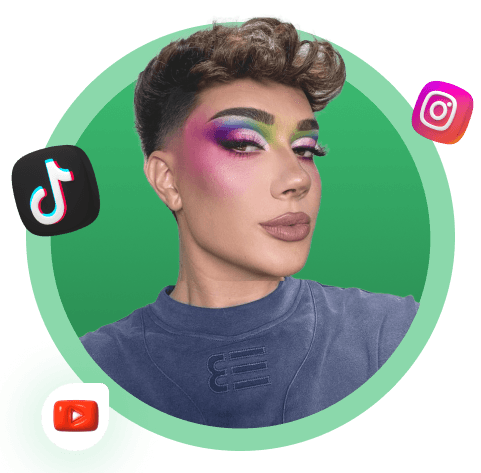
How to Measure Micro-Influencer Campaign Success?
How to Measure Micro-Influencer Campaign Success?
Understanding what worked is essential to maximizing your influencer campaign results. Here’s how to evaluate:
Engagement: Monitor likes, comments, and shares to assess audience response.
Reach & Impressions: Check audience size for overall exposure.
Conversions: Measure click-throughs, sales, or sign-ups to gauge ROI.
Audience Growth: Track new followers for alignment with your target market.
Sentiment: Analyze comments for feedback and brand fit.
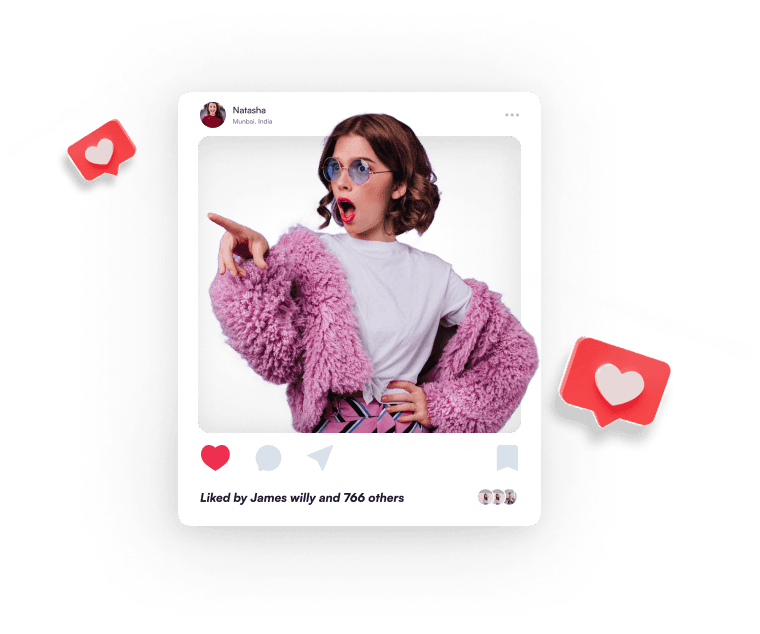

Frequently Asked Questions
Frequently Asked Questions
Who are micro-influencers on Instagram?
Is SocialiQ 2.0 a free tool?
How much do Instagram micro-influencers charge?
How much do TikTok micro-influencers charge?
How do I find micro-influencers near me?
How to find micro-influencers on Instagram?
How to find similar creators on TikTok?
How do I connect with Instagram influencers?
Who are micro-influencers on Instagram?
Is SocialiQ 2.0 a free tool?
How much do Instagram micro-influencers charge?
How much do TikTok micro-influencers charge?
How do I find micro-influencers near me?
How to find micro-influencers on Instagram?
How to find similar creators on TikTok?
How do I connect with Instagram influencers?
Who are micro-influencers on Instagram?
Is SocialiQ 2.0 a free tool?
How much do Instagram micro-influencers charge?
How much do TikTok micro-influencers charge?
How do I find micro-influencers near me?
How to find micro-influencers on Instagram?
How to find similar creators on TikTok?
How do I connect with Instagram influencers?
Who are micro-influencers on Instagram?
Is SocialiQ 2.0 a free tool?
How much do Instagram micro-influencers charge?
How much do TikTok micro-influencers charge?
How do I find micro-influencers near me?
How to find micro-influencers on Instagram?
How to find similar creators on TikTok?
How do I connect with Instagram influencers?
Need a guide on how to find micro-influencers
Need a guide on how to find micro-influencers
Need a guide on how to find micro-influencers
Need a guide on how to find micro-influencers
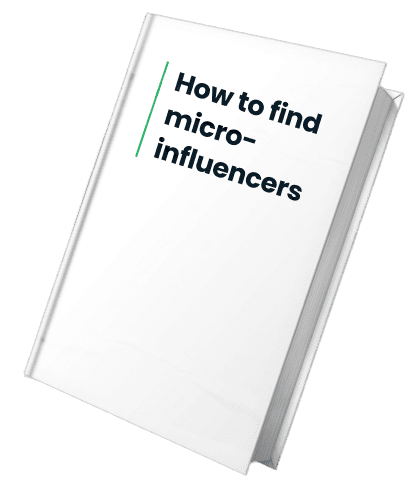

Additional Free Influencer Tools
Additional Free Influencer Tools
Explore more influencer marketing tools to optimize your strategy.
Explore more influencer marketing tools to optimize your strategy.
